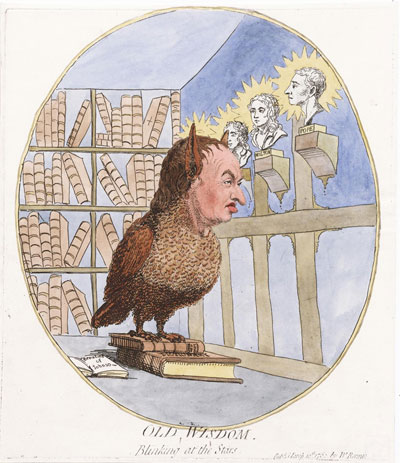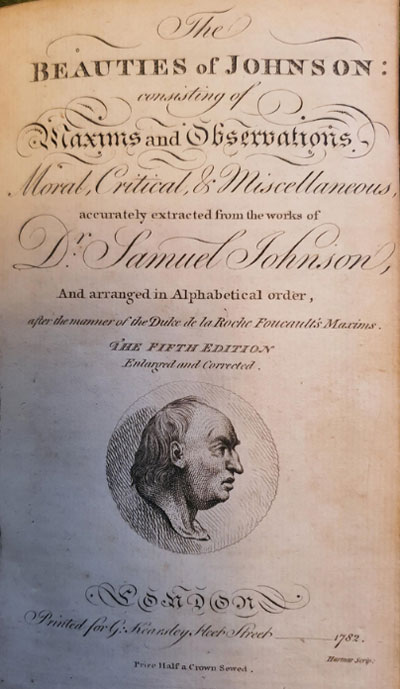Old Wisdom. Blinking at the Stars
This is the first of two prints by Gillray featuring Dr. Samuel Johnson (1709-1784), the eminent English poet, playwright, novelist, essayist, critic, and lexicographer. The second was Apollo and the Muses Inflicting Penance on Dr Pomposo (July 29, 1783) published the following year.

© Lewis Walpole Library, Yale University
Johnson is shown ambiguously with the body of an owl (usually considered wise because of its association with Athena, the goddess of Wisdom) and the ears of an ass (famous for subborness and stupidity). He stands perched upon two volumes labeled "Dictionary" and "Lives of the Poets," referring to his most indisputable achievement: the Dictionary of the English Language (1755) with approximately 40,000 definitions (all written by Johnson), and his most controversial one—"The Lives of the Most Eminent English Poets which included brief biographies and sometimes pointed assessments of over 50 poets. Two of those poets appear as busts above the owlish Johnson: Alexander Pope (whom he generaly liked) and John Milton (whose politics and some of his early poems he didn't).
Next to those books, however, is another book (the only one opened) labeled "Beauties of Johnson," which was only indirectly produced by Johnson. The full title is The Beauties of Johnson; conisting of Maxims and Observations, moral, critical, and miscellaneous, accurately extracted from the works of Dr. Samuel Johnson, And arranged in alphabetical order, after the manner of the Duke de la Roche-Foucault's Maxims. It was, as the title suggests, a compilation of quotations from Johnson's works, selected and published by the boookseller and publisher, George Kearsley.
As it happens, a new edition of the Beauties of Johnson was being advertised in the Morning Chronicle and the Morning Herald from January til April, 1782 coinciding nicely with Gillray's print in March of 1782. This edition included a title page with a profile of Johnson which bears such a striking resemblance to the profile in Old Wisdom that it is difficult not to conclude that The Beauties of Johnson was, in fact, the actual impetus for Gillray's print. Coupled with the fact that the publisher listed on the print (W. Rennie) seems to be fictional, this "coincidence" leads one to suspect that Kearsley may, in fact, have commissioned the print from Gillray as a further adverstising channel.

©Biblio.com
Sources and Reading
- Commentary from the British Museum on Old Wisdom. Blinking at the Stars.
- "Samuel Johnson," Wikipedia
- Philip Smallwood, Johnson's Critical Presence: Image, History, Judgment(2017), pp. 101-113
- Thomas Wright and Joseph Grego, The Works of James Gillray, the Caricaturist; With the History of His Life and Times, p. 33.
Comments & Corrections
NOTE: Comments and/or corrections are always appreciated. To make that easier, I have included a form below that you can use. I promise never to share any of the info provided without your express permission.